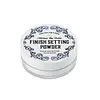Too Cool For School Artclass By Rodin Finish Setting Powder Versus Fenty Beauty Bright Fix Instant Brightening + Blurring Powder
What's inside
What's inside
 Key Ingredients
Key Ingredients

 Benefits
Benefits

 Concerns
Concerns

 Ingredients Side-by-side
Ingredients Side-by-side

Silica
AbrasiveSynthetic Fluorphlogopite
Boron Nitride
AbsorbentAluminum Starch Octenylsuccinate
AbsorbentSqualane
EmollientTriethoxycaprylylsilane
1,2-Hexanediol
Skin ConditioningGlyceryl Caprylate
EmollientAvena Sativa Kernel Flour
AbrasiveCrambe Abyssinica Seed Oil
Skin ConditioningGlycerin
HumectantWater
Skin ConditioningEpilobium Fleischeri Extract
Skin ConditioningCitric Acid
BufferingPotassium Sorbate
PreservativeMica
Cosmetic ColorantSynthetic Fluorphlogopite
Magnesium Myristate
Polymethyl Methacrylate
Silica
AbrasiveTapioca Starch
Lauroyl Lysine
Skin ConditioningSaccharomyces Ferment
Skin ConditioningOctyldodecyl Stearoyl Stearate
EmollientBoron Nitride
AbsorbentDiisostearyl Malate
EmollientSqualane
EmollientWater
Skin Conditioning1,2-Hexanediol
Skin ConditioningCaprylyl Glycol
EmollientStearoyl Glutamic Acid
CleansingPolymethylsilsesquioxane
Iron Oxides
Mica, Synthetic Fluorphlogopite, Magnesium Myristate, Polymethyl Methacrylate, Silica, Tapioca Starch, Lauroyl Lysine, Saccharomyces Ferment, Octyldodecyl Stearoyl Stearate, Boron Nitride, Diisostearyl Malate, Squalane, Water, 1,2-Hexanediol, Caprylyl Glycol, Stearoyl Glutamic Acid, Polymethylsilsesquioxane, Iron Oxides
 Reviews
Reviews

Ingredients Explained
These ingredients are found in both products.
Ingredients higher up in an ingredient list are typically present in a larger amount.
1,2-Hexanediol is a synthetic liquid and another multi-functional powerhouse.
It is a:
- Humectant, drawing moisture into the skin
- Emollient, helping to soften skin
- Solvent, dispersing and stabilizing formulas
- Preservative booster, enhancing the antimicrobial activity of other preservatives
Boron Nitride is compound consisting of boron and nitrogen. It is used to absorb oil and modify adherence/ slip in products.
This means it is often used in makeup products to help them last longer.
Silica, also known as silicon dioxide, is a naturally occurring mineral. It is used as a fine, spherical, and porous powder in cosmetics.
Though it has exfoliant properties, the function of silica varies depending on the product.
The unique structure of silica enhances the spreadability and adds smoothness, making it a great texture enhancer.
It is also used as an active carrier, emulsifier, and mattifier due to its ability to absorb excess oil.
In some products, tiny microneedles called spicules are made from silica or hydrolyzed sponge. When you rub them in, they lightly polish away dead skin layers and enhance the penetration of active ingredients.
Learn more about SilicaSqualane is an emollient that helps the skin hold onto moisture. It's an oily liquid that occurs naturally in certain types of fish and plant oils.
Because squalane boosts hydration in the skin, it also comes with plenty of benefits: it is an antioxidant and can help fight free radicals and skin damage. Squalane is also found to have a detoxifying effect when applied.
Squalane comes from squalene, which occurs naturally within the sebum of our skin. It is one of the oils our skin produces to keep itself hydrated. Squalane is the hydrogenated version of squalene and has a longer shelf life.
Research shows that squalane is non-irritating (even at 100% concentration).
In general, it's a fantastic ingredient. It does a great job at hydrating the skin, and it's suitable for those with sensitive skin.
The source of squalane may impact malassezia / fungal acne. This is because olive oil derived squalane can contain impurities such as fatty acids and plant waxes. Sugarcane derived squalane is recommended for anyone with malassezia concerns.
Is squalane vegan?
This depends on the source. Squalane can be derived from both plants and animals. Most squalane used in skincare comes from plants.
Please note: the source of squalane is only known if disclosed by the brand. We recommend reaching out to the brand if you have any questions about their squalane.
Read more about squalene with an "e".
Is squalane an oil?
Squalane is often called an oil, but it’s technically not; it’s a hydrocarbon, meaning it’s only made of carbon and hydrogen, unlike true oils which are triglycerides made of fatty acids and glycerol.
The term “oil-free” isn’t regulated, so companies can define it however they want. Some exclude all oils, while others just avoid mineral oil or comedogenic oils.
While some people avoid oils thinking they cause breakouts, the right kind of oil (or oil-like ingredient like squalane) can actually help balance and hydrate your skin. It’s worth testing out simple oils or squalane to see what works best for your skin.
Learn more about SqualaneSynthetic Fluorphlogopite is the synthethic version of mica. It consists of fluorine, aluminum and silicate.
Synthetic Fluorphlogopite is used to add volume to products.
It is considered non-irritating on the skin.
Learn more about Synthetic FluorphlogopiteWater. It's the most common cosmetic ingredient of all. You'll usually see it at the top of ingredient lists, meaning that it makes up the largest part of the product.
So why is it so popular? Water most often acts as a solvent - this means that it helps dissolve other ingredients into the formulation.
You'll also recognize water as that liquid we all need to stay alive. If you see this, drink a glass of water. Stay hydrated!
Learn more about Water